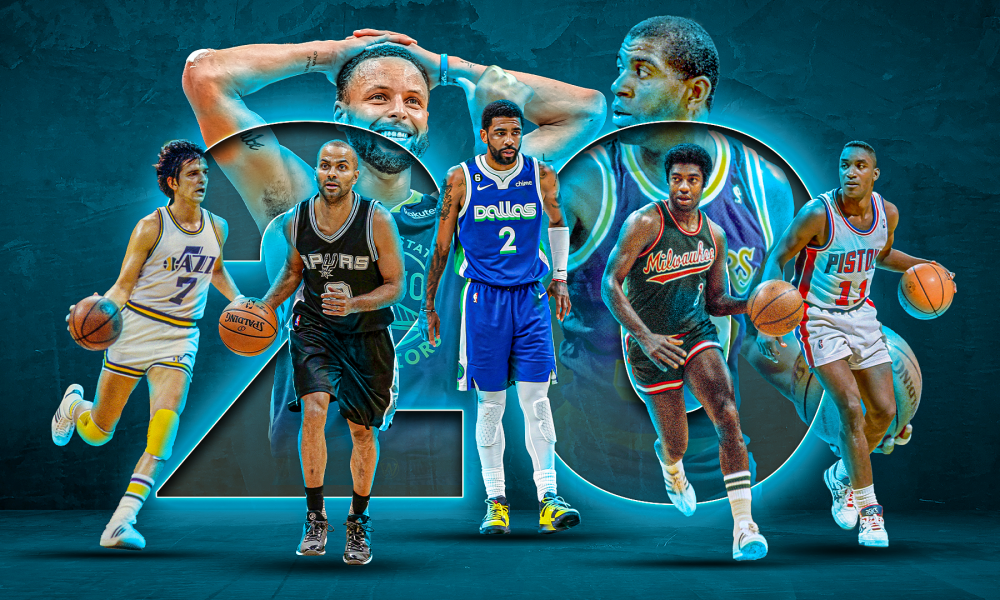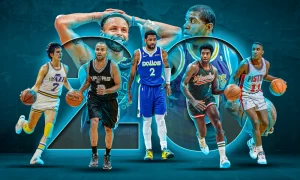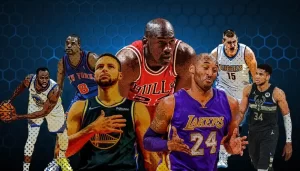Basketball Concepts
New Here?
Basketball Positions
Basketball Rules
Leagues and Associations
Contents
National Basketball Association
NBA Overview
The National Basketball Association (NBA) is the premier professional basketball league in the world and is headquartered in the United States. The league is currently comprised of 30 franchises, 29 in the United States and 1 in Canada. With projected revenues expected to exceed 10 billion over the next fiscal season, the NBA has established itself as one of the most profitable business enterprises in the world today.
When was the NBA Founded?
The NBA was founded in 1946 and was originally known as the Basketball Association of America (BAA). It operated for 3 seasons before merging with another professional basketball league, the National Basketball League (NBL), in 1949. After the merger, the league became known as the National Basketball Association (NBA), the name it has held to this day.
Who is the founder of the NBA?
Walter A. Brown, the owner of Boston Garden, was the founder of the Basketball Association of America. Originally a leading figure in professional hockey, Brown surmised that empty ice hockey arenas could also be used to host professional basketball games. After taking out a 2nd mortgage on his home, Brown first established the Boston Celtics in 1945 and then the Basketball Association of America the following year. After 3 somewhat successful yet volatile years that saw 4 teams fold between the 1st and 2nd seasons of the BAA, Brown headed the merger of the BAA and NBL, the union that created the NBA.
Who was the First NBA Player to get drafted?
The inaugural draft of the BAA was held in 1947 after its first season, with the Pittsburgh Ironmen selecting Clifton McNeely, a guard from Texas Wesleyan University. McNeely had enjoyed a successful collegiate career, leading the NAIA (National Association of Intercollegiate Athletics) in scoring his senior season. Ironically, McNeely never played a game in the NBA, choosing to pursue a career in coaching at the high school level. He became the head coach at Pampa High School in Pampa, Texas in 1948, compiling an impressive 320-43 record and 4 state championships during his time there. He also helped lead Pampa to an incredible 72-game winning streak from 1952 to 1955.
Rivalry with the ABA
The American Basketball Association (ABA) was a rival professional basketball league to the NBA from 1967 to 1976. It sought to cultivate a flashy, flamboyant atmosphere in direct contrast to the NBA, which had become very rigid, stale, and regimented over the years. The ABA introduced many innovations to the game of basketball including a red, white, and blue basketball, a 3-point line, and halftime entertainment shows. Many players in the ABA showcased incredible hairstyles, including some of the most massive afros in sports history sported by players such as Julius Erving, Artis Gilmore, and Darnell Hillman. Some of the most famous and infamous nicknames in basketball history originated from the ABA including “Dr. J” Julius Erving, the “Iceman” George Gervin, Marvin “Bad News” Barnes, Connie “the Hawk” Hawkins, Dan “the Horse” Issel, and “Mr. Excitement” Wendell Ladner. Other monikers for players and coaches throughout the league also include “Slick”, “Whopper”, “Fatty”, “Goo”, and Magnolia Mouth, exemplifying the creative, individualistic style that was ahead of its time in professional sports.
Although many initially scoffed at the idea of the ABA gaining ground in the world of American professional basketball, the league began to attract some of the biggest basketball stars of the day. Stars such as Rick Barry and Billy Cunningham briefly left the NBA for the ABA, while many college stars began to join the ABA as well. Fortunately for the NBA, the ABA never was able to gain solid financial footing at any point during its decade-long run. Teams were constantly changing ownership and folding, and even though the league had many young stars, teams would routinely play in front of nearly empty stadiums. Some of the facilities themselves were also very poor, with venues such as an airplane hangar, armory, and an ice-skating arena highlighting some of the more notorious examples. Eventually, the ABA folded in 1976, and the NBA absorbed 4 of the 7 remaining franchises, the San Antonio Spurs, Denver Nuggets, Indiana Pacers, and New York Nets.
NBA: Anatomy of a Season
Regular Season
The NBA regular season is comprised of a grueling, 82-game schedule that usually lasts from late October to the Middle of April. Because most Division 1 colleges play around 35 to 40 games, the adjustment period for NBA rookies is very difficult. The topic of shortening the regular season has been a regular discussion around the league for about a decade, with different plans for different game lengths routinely being proposed by the league and team officials. However, it is highly unlikely that a shorter regular season will be implemented any time soon, as it would be very difficult to find ways to make up the lost revenue from having fewer games.
All-Star Game
The NBA All-Star Game is held every February about two-thirds of the way through the NBA regular season. The NBA All-Star game is the culmination of a weekend of activities showcasing the talents of some of the biggest stars in the NBA. Events usually include a celebrity game, skills competition, 3-point contest, and slam dunk contest. The game previously used to pit the best Eastern Conference players against the best Western Conference players. However, the current format involves two team captains picking from a pool of 24-voted all-stars to compile a team.
Playoffs
20 of the 32 teams in the NBA make the playoffs, with the top six seeds in each conference initially getting a bye. The #7-#10 seeds in each conference have a play-in tournament to determine the #7 and #8 seeds in the first round of the playoffs in each conference. The #7 and #8 seeds play, with the winner being awarded the #7 seed in the playoffs. The #9 and #10 seeds also play, with the winner of the matchup facing the losing team of the #7 and #8 matchup, while the loser of the #9 and #10 matchup is eliminated. Finally, the loser of the #7 and #8 matchup plays the winner of the #9 and #10 matchup, with the winner being named the #8 seed and the loser being eliminated from the playoffs. The main playoffs then start with the 1 vs.8, 4 vs. 5, 3 vs. 6, and 2 vs.7 matchups in both conferences. Every matchup is a 7-game series, meaning a team has to win 4 games to advance to the next round. The winner of each conference meets in the NBA Finals to determine a champion.
Summer League
The NBA Summer League is held every year in Las Vegas and features young players, draft picks, walk-ons, and undrafted free agents. Each franchise in the NBA has a team, and teams play 5 games during a 10-day period. It has a dual purpose of developing young draft picks and allowing NBA teams to scout borderline NBA players to fill out their rosters.
What are the NBA Partner Leagues?
WNBA
The Women’s National Basketball Association (WNBA) is a professional basketball league for women founded in 1996 as a female counterpart to the NBA. The WNBA is currently made up of 12 teams, who play a 36-game regular season schedule from May to September, with the playoffs usually starting in late September. Starting in 2022, the top 8 teams make the playoffs without regard to conference affiliation and are matched up based on record, with 1 vs. 8, 4 vs. 5, 3 vs. 6, and 2 vs. 7 layouts in the first round. The first round of the playoffs is a best-of-3 format, while the semifinal and final matchups are a best-of-5 format.
NBA G-League
The G-League, previously known as the National Basketball Developmental League (NBDL), is the NBA’s minor league system. Each NBA team has an affiliate in the G-League, with the league itself boasting a regular season, playoffs, and all-star game.
NBA 2K League
The NBA 2k League is an e-sports league that is a joint venture between the NBA and Take-Two Interactive. Currently, 22 NBA teams have 2K League teams along with 2 international teams that compete against each other. To qualify for the NBA 2K League, players have to win several games in pro-am tournaments, submit an application to the 2K League, and then participate in a combine showcasing their gaming skills. E-sport participants are drafted and sign 6-month contracts to participate in the NBA 2K League.
Basketball Africa League
Founded in 2019, the Basketball Africa League was founded as a joint venture between the NBA and FIBA to create a professional basketball league in Africa. The league consists of 12 teams split up into 2 conferences, the Sahara and Nile conferences. Each team plays 5 regular season games, with the top 4 seeds in each conference advance to a single elimination playoff tournament.
Globalization of the NBA
The NBA is by far the most global professional sports league in the United States, with a wide range of influence all around the world. The NBA exploded onto the international scene during the 1992 Olympics at Barcelona, with the participation of the original Dream Team, arguably the greatest collection of basketball talent on a single roster of all time. Both Kobe Bryant and Yao Ming played a huge role in popularizing the game in China, where it is currently the country’s most popular sport. Former commissioner David Stern and current commissioner Adam Silver have also made huge investments in overseas NBA programs and growing the game abroad. At the start of the 2021-2022 season, the NBA had 109 international players on its rosters from 39 different countries, a testament to the huge strides the league has made in growing the game into a global power.
FAQs
Below are the original BAA had 11 teams for its inaugural 1946-1947 season in the order they finished the regular season.
Eastern Division
- Washington Capitols
- Philadelphia Warriors
- New York Knicks
- Providence Steamrollers
- Boston Celtics
- Toronto Huskies
Western Division
- Chicago Stags
- St. Louis Bombers
- Cleveland Rebels
- Detroit Falcons
- Pittsburgh Ironmen
There are currently 30 teams in the NBA. Below are the current teams in the NBA today in the order they finished the 2021-2022 regular season.
Eastern Conference
- Miami Heat
- Boston Celtics
- Milwaukee Bucks
- Philadelphia 76ers
- Toronto Raptors
- Chicago Bulls
- Brooklyn Nets
- Cleveland Cavaliers
- Atlanta Hawks
- Charlotte Hornets
- New York Knicks
- Washington Wizards
- Indiana Pacers
- Detroit Pistons
- Orlando Magic
Western Conference
- Phoenix Suns
- Memphis Grizzlies
- Golden State Warriors
- Dallas Mavericks
- Utah Jazz
- Denver Nuggets
- Minnesota Timberwolves
- Los Angeles Clippers
- New Orleans Pelicans
- San Antonio Spurs
- Los Angeles Lakers
- Sacramento Kings
- Portland Trail Blazers
- Oklahoma City Thunder
- Houston Rockets
Below are the original 17 NBA teams at the start of the 1949-1950 season after the merger in the order they finished the regular season.
Central Division
- Minneapolis Lakers
- Rochester Royals
- Fort Wayne Pistons
- Chicago Stags
- St. Louis Bombers
Eastern Division
- Syracuse Nationals
- New York Knicks
- Washington Capitols
- Philadelphia Warriors
- Baltimore Bullets
- Boston Celtics
Western Division
- Indianapolis Olympians
- Anderson Packers
- Tri-Cities Blackhawks
- Sheboygan Red Skins
- Waterloo Hawks
- Denver Nuggets







